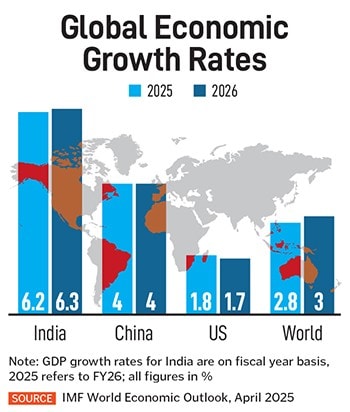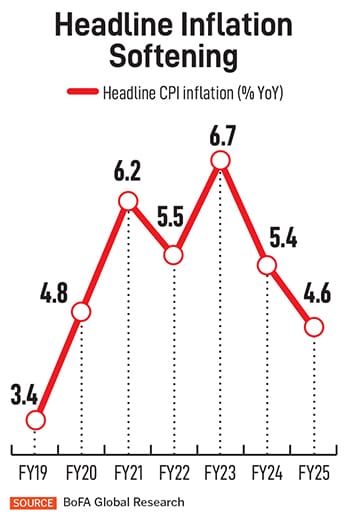For instance, India’s easing retail inflation may possibly lead to further monetary easing, leading to consumer demand growth. The softening of key commodity prices like Brent crude could translate into higher margins in corporate earnings, especially in the consumer segment. India could also be one of the most promising beneficiaries within Asia of the realignment of global supply chains due to higher tariffs imposed by the US on China.
“There is growing anecdotal evidence of trade diversion and supply chains shifting to India, due to (US President Donald) Trump’s higher tariffs on China and on competitor nations, the US’s goal of a strategic decoupling from China, India’s brisk progress on a trade deal with the US and its large domestic market,” say Sonal Varma and Aurodeep Nandi, economists, Nomura.
Over time, if these incentives sustain, both in the form of push factors (lower tariffs, de-risking, diversification) and pull factors (ease of doing business, domestic market size), then firms would relocate their factories, they feel. Most of these shifts are concentrated in the low- and mid-tech manufacturing sectors like electronics, textiles and toys, where low margins and higher tariffs on China make it imperative for firms to diversify their supply chains.
However, they add that overall while India’s economy remains vulnerable to a global growth slowdown, there are encouraging signs of relative gains. Varma and Nandi remain positive on the potential for India to emerge as a beneficiary of the next round of supply-chain shifts.
There are three caveats, though, according to them. India needs to complement any tariff arbitrage with earnest ease-of-doing-business reforms; second, India still depends heavily on imported components from China for its assembly of electronics products and solar equipment; third, the trade diversion to India could include some rerouting of Chinese exports to the US and thus requires stricter “rules of origin” enforcement.
Pramod Amthe, head of institutional equity research, InCred Capital, believes that the government’s initiative to cut income-tax rates and the Reserve Bank of India’s (RBI) move to improve liquidity and two successive repo rate cuts in the last three months are targeted to revive the growth momentum.
“Despite a seasonally strong March quarter, a mixed trend in macro variables sustained, as improvement in rural demand, electricity demand and easing inflation was overshadowed by slow automobile & housing sales, easing Index of Industrial Production (IIP) growth, and weakness in credit disbursal as well as government capex,” Amthe explains.
At the same time, he is also concerned that rising trade protectionism, currency war threat, geopolitical tensions, and volatile oil prices may exert downward pressure on the economy.

According to economists at QuantEco Research, India’s GDP growth is seen to have a strong correlation with global economic growth, especially in the recent two decades. They estimate that India’s GDP growth moderates by 40 basis points for every 1 percent decline in global GDP growth. “As such, 60 bps moderation in annualised global growth in 2025 could imply a 20-30 bps of downside for India’s FY26 GDP growth outlook,” they say.
Also Read: How climate change can impact GDP and jobs

Weather impact on food price
One of the most encouraging factors, currently, is the easing of the stubborn food-price led inflation. After experiencing multiple supply shocks, the consumer price index (CPI) inflation came off to a six-year low in FY25, at 4.6 percent. The gap between core CPI inflation and food inflation had stayed wide for a long time in FY25 and has converged with food prices coming off towards core inflation.
“The tepid growth backdrop means demand-led price pressures are likely to be soft, and food inflation pressures are coming off, as input costs, food production and supply chains align towards a lower inflation regime,” says Rahul Bajoria, managing director, head of India and ASEAN economic research, Bank of America.
Vegetable prices, which were elevated for a few months in the second half of 2024, have corrected sharply. Even within non-perishables like cereals, pulses, and spices, Bajoria sees downward inflation momentum, and it is only cooking oil and fruits that currently show high inflation. “With summer months so far not showing any material signs of a price increase in perishables, food inflation may stay low for some time given adequate supply and high base effects, keeping headline inflation below 4 percent for most of 2025,” Bajoria adds.
 According to his estimates, India will continue to meet its inflation target for an extended period, expecting headline inflation to fall to a seven-year low of 3.8 percent year-on-year in FY26 from 4.6 percent in FY25. “We continue to see the RBI continuing its path of interest rate cuts, expecting another 50 basis points of rate cuts in the next two meetings, with risks of more cuts emanating from a potentially larger growth slowdown,” he says.
According to his estimates, India will continue to meet its inflation target for an extended period, expecting headline inflation to fall to a seven-year low of 3.8 percent year-on-year in FY26 from 4.6 percent in FY25. “We continue to see the RBI continuing its path of interest rate cuts, expecting another 50 basis points of rate cuts in the next two meetings, with risks of more cuts emanating from a potentially larger growth slowdown,” he says.
The RBI has also continued to ease liquidity conditions through a combination of bond purchases and foreign exchange operations, signalling its comfort in maintaining adequate liquidity in the banking system.
Economists at QuantEco Research also expect sizeable and broad-based correction in food prices in FY26, led by vegetables, reinforced by the expectations of an above-normal monsoon. Further, the upside in core-core inflation (that excludes petrol, diesel, gold, silver etc.) is likely to remain capped, amidst trade driven downside risks to global growth and, in turn, global commodity prices.
“The easing CPI inflation, coupled with lower interest rates and regulatory easing, could possibly support quicker expansion of consumer credit and, in turn, leveraged consumption. However, trade uncertainties could impinge on the pace of urban jobs growth, especially in the private sector,” say economists at QuantEco Research.
Amidst food prices corrections, a healthy rabi output, the outlook of an above-normal monsoon and unconditional cash transfers seeing a complete rollout in FY26, they expect the rural consumption recovery to continue well into FY26.
The Indian Meteorological Department (IMD) forecasts Southwest monsoon to be ‘above normal’ in 2025. However, the total number of heatwave days has seen a continued increase in the last three years. The IMD had already issued a warning of higher-than-normal temperatures for months of March to May.
Capex: Laggards?
Capital expenditure has been the weakest link in the FY25 fiscal accounts of the general government (Centre and states). For 11 months in FY25, estimates by Kotak Institutional Equities show general government capex growth declined at -1 percent. The Centre’s capex growth was 0.8 percent in 11MFY25 with support from states’ loans, roads and railways. Most of the weakness stemmed from defence, telecommunication, economic affairs and steel. The states’ capex growth was at 0.2 percent in 11MFY25 and 60 percent of FY2025 budget estimates.
“Based on the year-end spending trend, the Centre and states had a tall task to meet expenditure targets in March. States have historically fallen short of budgeted spending. Given budgeted targets, the governments’ capital expenditure growth is likely to remain relatively muted in FY2026,” analysts at Kotak Institutional Equities say.
Among the larger spending areas, revenue expenditure was relatively muted for drinking water and sanitation and transfers to states, while a healthy pace was seen in health, agriculture, subsidies, defence and rural development.
Mapping new project announcements in the 11 months of FY25, economists at the Bank of Baroda say that companies and governments have shown the intent to invest ₹38.3 lakh crore, which is second highest on record since FY96. Domestic private companies accounted for the majority (62 percent) of the new projects announced in the last fiscal (April 2024-March 2025), amounting to ₹22.6 lakh crore.
The next big set of investments was announced by the public sector (central, state governments, local bodies) at ₹11.1 lakh crore (31 percent of total), followed by foreign private firms (₹2.6 lakh crore; 7 percent).
Also Read: Doubling India’s GDP by 2030: Triumph through tech, talent and tenacity

Growth forecast: A series of downgrades
In April, the IMF slashed India’s growth forecast to 6.2 percent in FY26 due to tariff uncertainties, with a further reduction to 6.3 percent projected for FY27.
However, the IMF says that, for India, the growth outlook is relatively more stable, supported by private consumption, particularly in rural areas, but this rate is 0.3 percentage points lower than that in the January 2025 WEO Update on account of higher levels of trade tensions and global uncertainty.
For similar reasons of a severe escalation in the global trade war, Fitch Ratings also cut India’s GDP growth estimate by 10 basis points to 6.4 per cent for FY26 but retained the projections for next fiscal.
“It is hard to predict the US trade policy with any confidence. The massive policy uncertainty is hurting business investment prospects, equity price falls are reducing household wealth, and US exporters will be hit by retaliation,” Fitch says.
Due to the US tariffs uncertainties, Moody’s Analytics also cut India’s growth forecast to 6.1 percent in 2025, lowering it by 30 basis points from its March projection.
Amidst the growth target downgrade scenarios, RBI has the most optimistic outlook on India’s GDP for FY26. Even as the central bank has lowered its GDP target for this fiscal, it is still the highest among all. In its latest monetary policy review, RBI lowered GDP forecast to 6.5 percent, from 6.7 percent in FY26, due to the global trade volatility and policy uncertainties.




 According to his estimates, India will continue to meet its inflation target for an extended period, expecting headline inflation to fall to a seven-year low of 3.8 percent year-on-year in FY26 from 4.6 percent in FY25. “We continue to see the RBI continuing its path of interest rate cuts, expecting another 50 basis points of rate cuts in the next two meetings, with risks of more cuts emanating from a potentially larger growth slowdown,” he says.
According to his estimates, India will continue to meet its inflation target for an extended period, expecting headline inflation to fall to a seven-year low of 3.8 percent year-on-year in FY26 from 4.6 percent in FY25. “We continue to see the RBI continuing its path of interest rate cuts, expecting another 50 basis points of rate cuts in the next two meetings, with risks of more cuts emanating from a potentially larger growth slowdown,” he says.















![Top 10 Countries With Most Powerful Military Strength [2025] – Forbes India Top 10 Countries With Most Powerful Military Strength [2025] – Forbes India](https://i1.wp.com/images.forbesindia.com/media/images/2023/Nov/img_223273_top10countrieswithstrongestmilitarypower.jpg?w=400&resize=400,240&ssl=1)
![Top 10 Countries With Most Powerful Military Strength [2025] – Forbes India Top 10 Countries With Most Powerful Military Strength [2025] – Forbes India](https://i1.wp.com/images.forbesindia.com/media/images/2023/Nov/img_223273_top10countrieswithstrongestmilitarypower.jpg?w=80&resize=80,80&ssl=1)





